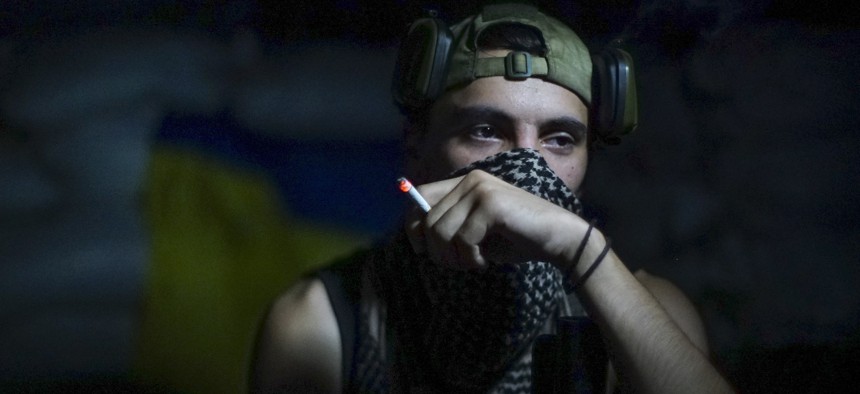
In this photo taken on Friday, Aug. 26, 2016, a Ukrainian soldier smokes in the village of Marinka, near Donetsk, eastern Ukraine. More than 9,500 people have been killed in the fighting that began in April 2014, according to United Nations figures, AP / MAX BLACK
As Fighting Resumes, Ukraine Extends a Wary Hand to Washington
Past missteps and half-measures have undermined trust in the U.S, but commanders still say there are ways to help.
The renewed fighting in eastern Ukraine has reignited the debate in Washington about how best to support Kiev’s battle with separatists and their backers in Moscow. One front-line Ukrainian commander has been waiting years for arms and other equipment from Washington. His message, in a telephone conversation with Defense One, was I need help, and equipment, but: “Don’t send shit to me.”
In mid-December, leaders from U.S. European Command, or EUCOM, discussed security cooperation and military reform with Stepan Poltorak, Ukraine’s defense minister, and Viktor Muzhenko, Ukraine’s Chief of General Staff. “Additionally, we visited the Eastern part of the country where Ukrainian military units are involved in combat operations against Russia-led separatist forces,” a EUCOM representative said. “We remain concerned with the violence in eastern Ukraine and continue to call for an immediate end to Russia's occupation of Crimea and for Russia to cease its destabilizing actions in Ukraine and fulfill its commitments in the Minsk agreements.”
Recent fighting has left 17,000 civilians, including 2,500 children, without heat, water, or electricity. Natan Chazin is an advisor to Muzhenko and the commander of Ukraine’s newly formed Command, Control, Communications, Computers, Intelligence, Surveillance and Reconnaissance, or C4ISR, unit. He says that Russian media in the region blames the outages on the Ukrainians. Dozens of Ukrainian soldiers and civilians have lost their lives in the recent fighting.
The recently passed 2017 National Defense Authorization Act allows the president to send military equipment, including arms, to Ukraine. However unlikely that may seem, given Donald Trump’s many overtures to Russia, Sen. John McCain nevertheless is urging him to do so. In a Feb. 2 letter, the Arizona Republican urged the president to expand sanctions against Russia and accelerate the delivery of weapons.
“America does have a proud history of helping free people to defend themselves. We should do so once more by giving our Ukrainian friends the assistance they need and deserve,” McCain wrote. “Failing to do so now not only risks Ukraine’s sovereignty, but the further erosion of American credibility.”
It’s been a long and difficult effort. In 2014, Ukrainian military units were requesting Javelin anti-tank weapons, plus radios, radars, and drones. Instead, they received some nonlethal aid.
Chazin is on the front line of the most intensive electromagnetic warfare environment on Earth. The approximately 200-man unit, formed last May, does drone jamming, visual reconnaissance, mapping, situational awareness, and more.
“It contains everything from snipers to engineers,” he said.
Chazin has become increasingly suspicious of Washington’s offers to help. Dumb mistakes and miscommunications in dealing with military bureaucracy have been an ongoing headache, he said, delaying or even diverting promised equipment. Even when U.S. officials keep a promise to the Ukrainian military, he said, they often fumble the execution or the delivery.
He cited the case of the 72 Pentagon-supplied Raven RQ-11B drones that were meant to help Ukrainian troops with vital reconnaissance operations.
“A group of 30 guys went to America for three months’ training in [how to operate the] Raven,” he said, after the drones were allocated for the Ukrainian military. But bureaucratic bungling on both ends sent the drones to a completely different group of soldiers. He had one word for this: “stupid.”
The Ravens provided a video feed along an analog signal. “The analog media gives away your coordinates,” said Chazin. “They jammed the signal and stole our positions!”
The U.S. also provided Harris radios to the Ukrainian front line to enable encrypted communications. But, as the Washington Post reported last year, the radios’ encrypted signal is much more powerful than that of conventional radios, which enabled Russian forces to target their users.
“We have thousands of Harris’s but not the right transmitters. American aid coming to us is coming without any guide,” said Chazin.
Expand the Training Operation
One area of U.S. military partnership that Chazin would like to see expanded is training for Ukrainian soldiers. There are currently about 350 U.S. troops helping to train their Ukrainian counterparts as part of the Joint Multinational Training Group, Ukraine. The goal is to train up to six battalions of Ukrainian conventional special operations forces.
“The most important thing that we've done is train their military and train their trainers so that they can now train their military,” a senior U.S. defense official said. “The Russian military modernized over the course 15 years. But Ukraine has had just 15 months. They can never catch up to Russia, just because of the size, but they've come a long, long way.”
How important is the training program to Ukraine’s resistance to Russian pressure? “Essential,” the official said.
Chazin noted that the Ukrainian campaign had lessons for the American trainers as well.
“We are facing hybrid war, [an adversary] with artillery that no one else has. There’s nobody doing this but us,” he said.




